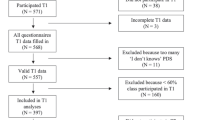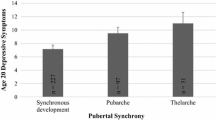Abstract
The relative nature of pubertal timing has received little attention in research linking early pubertal development with psychological adjustment. The current study examines the dynamic association between pubertal timing and internalizing symptoms among an urban, ethnically diverse sample of girls (n = 1,167; 50% Latina, 30% Black/African American, 11% Asian, 9% White). By relying on six waves of data, we detected substantial within-person variability in pubertal timing, which in turn related to fluctuations in depressive symptoms, global self-worth, and social anxiety in multilevel analyses. Within-person changes in the direction of more advanced development compared to peers consistently predicted more depressive symptoms; however, more advanced development was related to lower self-worth only at the beginning of middle school. By the end of middle school, less advanced development predicted social anxiety. Results challenge the notion that pubertal timing is a stable individual characteristic, with implications for studying the psychosocial correlates of pubertal development across multiple years.


Similar content being viewed by others
References
Benner, A. D., & Graham, S. (2009). The transition to high school as a developmental process among multiethnic urban youth. Child Development, 80(2), 356–376.
Brooks-Gunn, J., Warren, M. P., Rosso, J., & Gargiulo, J. (1987). Validity of self-report measures of girls’ pubertal status. Child Development, 58(3), 829–841.
Carter, R., Caldwell, C., Matusko, N., Antonucci, T., & Jackson, J. (2010). Ethnicity, perceived pubertal timing, externalizing behaviors, and depressive symptoms among black adolescent girls. Journal of Youth and Adolescence. doi:10.1007/s10964-010-9611-9.
Carter, R., Jaccard, J., Silverman, W. K., & Pina, A. A. (2009). Pubertal timing and its link to behavioral and emotional problems among `at-risk’ African American adolescent girls. Journal of Adolescence, 32(3), 467–481.
Dick, D. M., Rose, R. J., Viken, R. J., & Kaprio, J. (2000). Pubertal timing and substance use: associations between and within families across late adolescence. Developmental Psychology, 36(2), 180–189.
Ge, X., Brody, G. H., Conger, R. D., & Simons, R. L. (2006a). Pubertal maturation and African American children’s internalizing and externalizing symptoms. Journal of Youth and Adolescence, 35(4), 528–537.
Ge, X., Brody, G. H., Conger, R. D., Simons, R. L., & Murry, V. M. (2002). Contextual amplification of pubertal transition effects on deviant peer affiliation and externalizing behavior among African American children. Developmental Psychology, 38(1), 42–54.
Ge, X., Conger, R. D., & Elder, G. H., Jr. (2001). Pubertal transition, stressful life events, and the emergence of gender differences in adolescent depressive symptoms. Developmental Psychology, 37(3), 404–417.
Ge, X., Kim, I. J., Brody, G. H., Conger, R. D., Simons, R. L., Gibbons, F. X., et al. (2003). It’s about timing and change: pubertal transition effects on symptoms of major depression among African American youths. Developmental Psychology, 39(3), 430–439.
Ge, X., Natsuaki, M. N., & Conger, R. D. (2006b). Trajectories of depressive symptoms and stressful life events among male and female adolescents in divorced and nondivorced families. Development and Psychopathology, 18(1), 253–273.
Ge, X., Natsuaki, M. N., Neiderhiser, J. M., & Reiss, D. (2007). Genetic and environmental influences on pubertal timing: Results from two national sibling studies. Journal of Research on Adolescence, 17(4), 767–788.
Graber, J. A., Lewinsohn, P. M., Seeley, J. R., & Brooks-Gunn, J. (1997). Is psychopathology associated with the timing of pubertal development? Journal of the American Academy of Child and Adolescent Psychiatry, 36(12), 1768–1776.
Graber, J. A., Seeley, J. R., Brooks-Gunn, J., & Lewinsohn, P. M. (2004). Is pubertal timing associated with psychopathology in young adulthood. Journal of the American Academy of Child and Adolescent Psychiatry, 43(6), 718–726.
Graham, S., Bellmore, A., & Juvonen, J. (2003). Peer victimization in middle school: When self-and peer views diverge. Journal of Applied School Psychology, 19(2), 117–137.
Harter, S. (1985). Manual for the self-perception profile for children. Denver, CO: University of Denver.
Haynie, D. L. (2003). Contexts of risk? Explaining the link between girls’ pubertal development and their delinquency involvement. Social Forces, 82(1), 355–397.
Hayward, C., Gotlib, I. H., Schraedley, P. K., & Litt, I. F. (1999). Ethnic differences in the association between pubertal status and symptoms of depression in adolescent girls. Journal of Adolescent Health, 25(2), 143–149.
Hayward, C., Killen, J. D., Wilson, D. M., Hammer, L. D., Litt, I. F., Kraemer, H. C., et al. (1997). Psychiatric risk associated with early puberty in adolescent girls. Journal of the American Academy of Child and Adolescent Psychiatry, 36(2), 255–262.
Hirsch, B. J., & Rapkin, B. D. (1987). The transition to junior high school: A longitudinal study of self-esteem, psychological symptomatology, school life, and social support. Child Development, 58(5), 1235–1243.
Jin, R., Ge, X., Brody, G., Simons, R., Cutrona, C., & Gibbons, F. (2008). Antecedents and consequences of psychiatric disorders in African-American adolescents. Journal of Youth and Adolescence, 37(5), 493–505.
Kovacs, M. (1985). The children’s depression inventory (CDI). Psychopharmacology Bulletin, 21(4), 995–998.
Kovacs, M. (1992). Children’s depression inventory: Manual. New York: Multi-Health Systems.
La Greca, A. M., & Lopez, N. (1998). Social anxiety among adolescents: Linkages with peer relations and friendships. Journal of Abnormal Child Psychology, 26(2), 83–94.
Lynne, S. D., Graber, J. A., Nichols, T. R., Brooks-Gunn, J., & Botvin, G. J. (2007). Links between pubertal timing, peer influences, and externalizing behaviors among urban students followed through middle school. Journal of Adolescent Health, 40(2), 181.e7–181.e13.
McCartney, K., & Rosenthal, R. (2000). Effect size, practical importance, and social policy for children. Child Development, 71(1), 173–180.
Mendle, J., Turkheimer, E., & Emery, R. E. (2007). Detrimental psychological outcomes associated with early pubertal timing in adolescent girls. Developmental Review, 27(2), 151–171.
Nadeem, E., & Graham, S. (2005). Early puberty, peer victimization, and internalizing symptoms in ethnic minority adolescents. The Journal of Early Adolescence, 25(2), 197–222.
Nylund, K., Bellmore, A., Nishina, A., & Graham, S. (2007). Subtypes, severity, and structural stability of peer victimization: What does latent class analysis say? Child Development, 78(6), 1706–1722.
Obeidallah, D., Brennan, R. T., Brooks-Gunn, J., & Earls, F. (2004). Links between pubertal timing and neighborhood contexts: Implications for girls’ violent behavior. Journal of the American Academy of Child and Adolescent Psychiatry, 43(12), 1460–1468.
Petersen, A., Crockett, L. J., Richards, M., & Boxer, A. (1988). A self-report measure of pubertal status: Reliability, validity, and initial norms. Journal of Youth and Adolescence, 17, 117–133.
Preacher, K. J., Curran, P. J., & Bauer, D. J. (2006). Computational tools for probing interactions in multiple linear regression, multilevel modeling, and latent curve analysis. Journal of Educational and Behavioral Statistics, 31(4), 437–448.
Raudenbush, S. W., Bryk, A. S., Cheong, Y. F., & Congdon, R. (2000). HLM5: Hierarchical linear and nonlinear modeling (2000th ed.). Chicago: Scientific Software.
Reardon, L. E., Leen-Feldner, E. W., & Hayward, C. (2009). A critical review of the empirical literature on the relation between anxiety and puberty. Clinical Psychology Review, 29(1), 1–23.
Reynolds, B., & Juvonen, J. (2011). The role of early maturation, perceived popularity, and rumors in the emergence of internalizing symptoms among adolescent girls. Journal of Youth and Adolescence. doi:10.1007/s10964-010-9619-1.
Rosenthal, R. (1994). Parametric measures of effect size. In H. Cooper & L. V. Hedges (Eds.), The handbook of research synthesis (pp. 231–244). New York: Russel Sage Foundation.
Siegel, J. M., Yancey, A. K., Aneshensel, C. S., & Schuler, R. (1999). Body image, perceived pubertal timing, and adolescent mental health. Journal of Adolescent Health, 25(2), 155–165.
Simmons, R. G., Blyth, D. A., Van Cleave, E. F., & Bush, D. M. (1979). Entry into early adolescence: The impact of school structure, puberty, and early dating on self-esteem. American Sociological Review, 44(6), 948–967.
Singer, J. D., & Willett, J. B. (2003). Applied longitudinal data analysis: Modeling change and event occurrence. New York, NY: Oxford University Press.
Susman, E. J., & Dorn, L. D. (2009). Puberty: Its role in development. In R. M. Lerner & L. Steinberg (Eds.), Handbook of adolescent psychology (3rd ed.). Hoboken: Wiley.
Zehr, J. L., Culbert, K. M., Sisk, C. L., & Klump, K. L. (2007). An association of early puberty with disordered eating and anxiety in a population of undergraduate women and men. Hormones and Behavior, 52(4), 427–435.
Acknowledgments
This study was funded by grants from the National Science Foundation (BCS-9911525) and the William T. Grant Foundation (99100463) awarded to Sandra Graham and Jaana Juvonen and a Ruth L. Kirschstein National Research Service Award (NRSA) to Bridget Reynolds (F31 MH074244). We thank Drs. Sandra Graham, Rena Repetti, Andrew Fuligni, and Ted Robles for their comments and advice on earlier drafts of this paper. We would also like to thank Mike Robinson, the Peer Project, and the Relationships and Health Lab for their invaluable feedback and support.
Author information
Authors and Affiliations
Corresponding author
Rights and permissions
About this article
Cite this article
Reynolds, B.M., Juvonen, J. Pubertal Timing Fluctuations across Middle School: Implications for Girls’ Psychological Health. J Youth Adolescence 41, 677–690 (2012). https://doi.org/10.1007/s10964-011-9687-x
Received:
Accepted:
Published:
Issue Date:
DOI: https://doi.org/10.1007/s10964-011-9687-x




